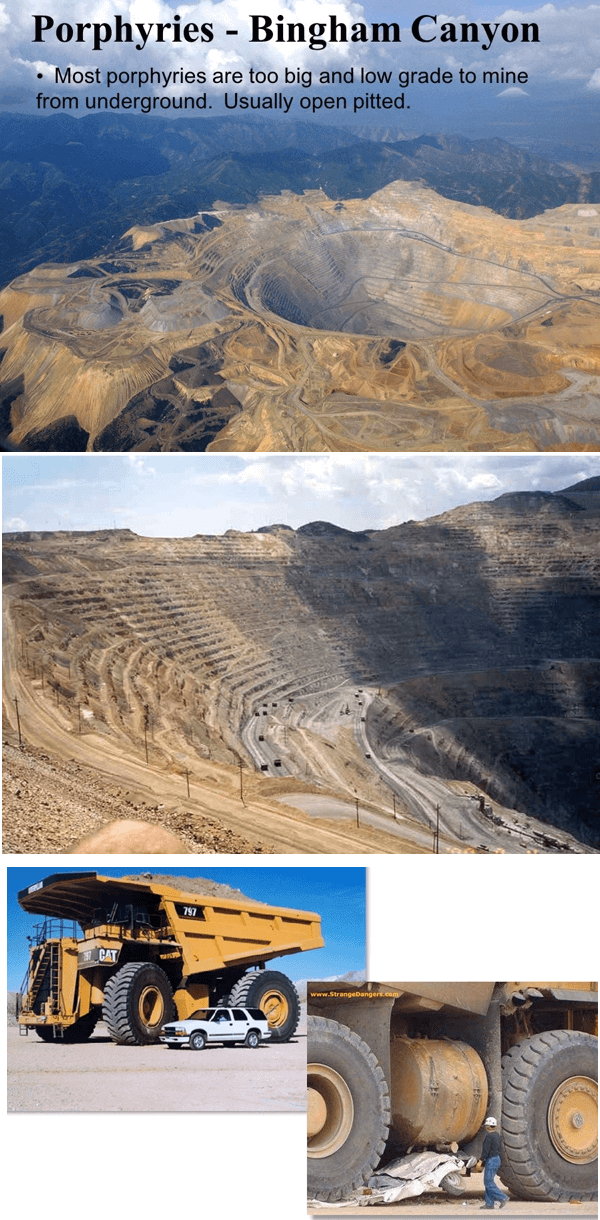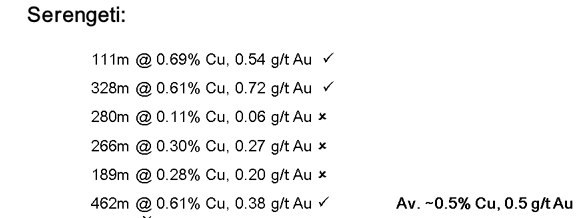
Here let’s understand the geology of porphyries and iron oxide copper gold deposits or IOCG as they are known. These are somewhat the giants of the ore deposits world. As a mining interested learner, the geology of porphyry copper deposits is vital to your education.
Now in the first Exploration Geology Course I discussed how because our current mining technology all the metals that we use are mined from the top 4 km of the earth’s crust. I also showed why with the crustal abundance or the average crustal abundance of metals wasn’t good enough for economic mining and that nature needed to provide a major concentration of the metals in order to make the grades which can be economically mined. You will also remember that nature concentrates the metals by a process of partially melting the crustal rocks at depth and letting them rise through the crust and cool and then dumping the value less minerals such as feldspars and quartz and concentrating the metals in the remaining magma and hydrothermal fluids. In the second talk in this series I spoke about the deposits associated with mafic layered complexes and kimberlites. In this talk I will focus on the porphyry and IOCG deposits which develop at a slightly shallower depth that the mafic layered complexes, generally in the range of 4 or 5 to 1 km depth. Porphyry deposits and IOCG’s are the world’s primary source of copper and they account for more than 60% of the copper production globally but in addition to copper they also supply 100% of the world’s molybdenum production, 10 to 15% of global uranium production and a significant proportion of the world’s gold production in short they make up a critical group of deposits.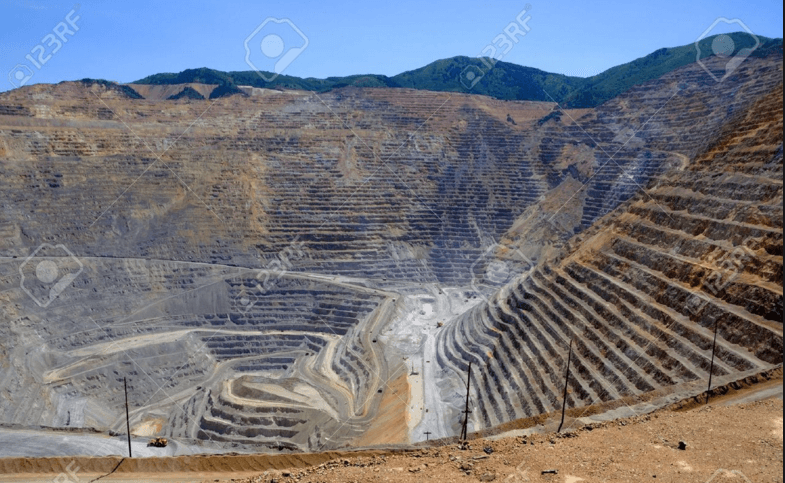
So let’s start off now with porphyries. Whereas the mafic layered complexes we discussed in the last talk usually develop relatively deep in the earth’s crust porphyries form at a much shallower depth not quite as shallow as epithermal deposits but not much deeper than them either. Porphyries generally form in and around the magma chambers that feed volcanoes. This is Mount St Helens a few years after it blew its top. A seismic survey showed that the main magma chamber stems from 7 km below the surface down to about 12 km below the surface but the data from the earthquake epicenters shows that there is a smaller magma chamber at a depth of about 2 km and that is the focus of the seismic activity. It is likely that this upper chamber is where the hydrothermal fluids are collecting and mineralizing the surrounding rocks. Mount St Helens is a porphyries deposit in the making. The steam you can see rising above the new forming dome in the picture on the left there is leakage of the mineralizing fluids. When it comes to porphyry deposits there are a number of variations on a theme and the deposits can be copper only, they can be copper gold, copper molybdenum or molybdenum only but regardless of the metal mix the process of deposit formation is the same.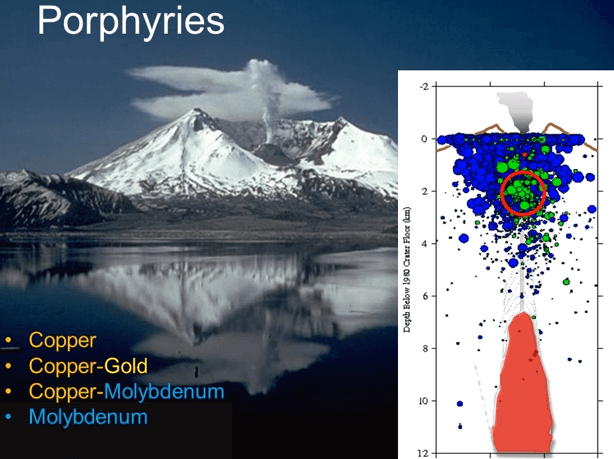
Now let’s go through that process. Generally the parent magma is a product of partial melting of a slab of oceanic crust and sediments and it is subducted beneath the continental margin. The melt rises up through the overriding continental plate and collects in one or more magma chambers and eventually erupts at surface releasing the pressure and building a volcanic cone. Once the eruption is over the magma in the neck of the volcano solidifies and plugs the vent. The magma then continues to accumulate in a chamber below and it starts to cool. 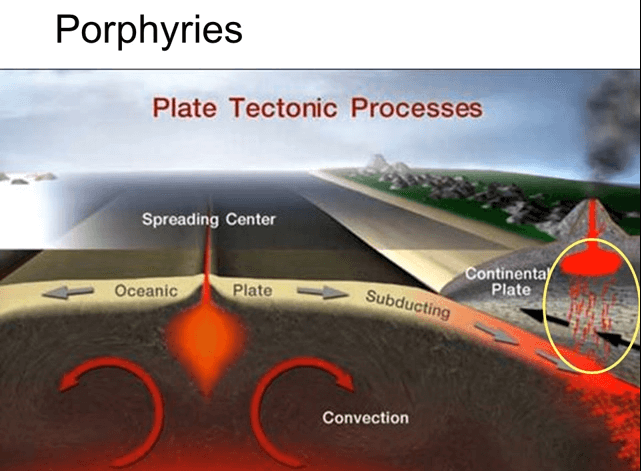 As the magma chamber cools from the contact inwards barren feldspars and quartz crystallize out and the remaining melts becomes enriched then melts, volatiles mainly water, carbon dioxide and hydrogen sulfide. The volatiles migrate to the top of the chamber and accumulates at the foam in a glass beer and allergy that were used in the first of the Exploration Geology Courses.
As the magma chamber cools from the contact inwards barren feldspars and quartz crystallize out and the remaining melts becomes enriched then melts, volatiles mainly water, carbon dioxide and hydrogen sulfide. The volatiles migrate to the top of the chamber and accumulates at the foam in a glass beer and allergy that were used in the first of the Exploration Geology Courses.
Now feldspar crystals take up more space than feldspar melt and this combined with the accumulating steam and gas builds up pressure inside the chamber until the surrounding rocks can no longer contain it. The cool solid rine to the magma chamber and the country rock above it rupture in the volatiles escape carrying their metals into the fractured rock. The fluids have a high salt or sodium chloride content and the metals are generally transported as chloride complexes as the metal rich steam makes its way upwards through the cooler rocks it condenses into brine and then the metals start to deposit as the temperature drops below about 350°C. The metals drop out progressively starting with copper and molybdenum and then led and zinc once the temperature drops to below 250°C. If gold is present it will drop out across the temperature spectrum.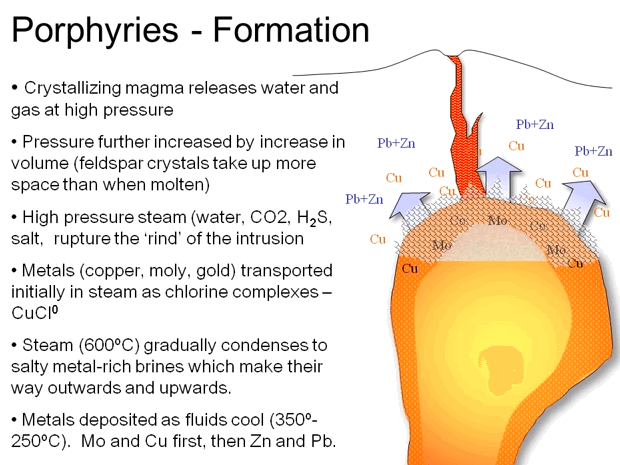
Because mineralization relies on this cracking of the carcase around cooling magma chamber the mineralization is associated with a dense network of fine veinlets rather than a few major veins. Mineralized veins are often only a millimeter or two across but the grade comes from the high density of the veinlets. The host-rock is progressively altered by the hydrothermal fluids that pas through it. Initially the iron and magnesium bearing minerals such as biotite, amphibi, amphibole and pyroxene are altered to chlorite, actinalite, epidote and calcite giving the rock a greenish tinge. This is the prophylactic alteration that you hear geologist talking about and you can see examples of it in the photo on the left of the screen. On the margins of the magma chamber where large volumes of groundwater pass through the rock driven by convection and the heat of the intrusion, feldspars breakdown to cerasite mica giving the rock a creamy color as in the photo on the top right. This is termed filic alteration. As the alteration progresses further still more silica and potassium is added to the rock the chlorite, amphibole and pyroxene that were formed earlier are altered of biotite, magnetite and the plagio clays and auto clays feldspars are altered to potassium feldspar. This is referred to as potassic alteration and is the best host for the mineralization in other words the more progressively altered the better the chance of mineralization. The rock on the bottom right has suffered this potassic alteration; pink-orange mineral is potassium feldspar. The sulfide minerals can’t be seen in this photo but they are generally hosted in those gray salacious veinlets. These alteration types become important in the exploration of porphyry style mineralization as they provide vectors to the mineralization.
This primary mineralizing event yield only low grade mineralization, grades of 0.3 to 0.9% copper less than 1% almost always are typical for primary grade porphyry mineralization with each pulse in fluid extending to enrich the final grade more pulses of fluid the higher the final grade. The mineralization frequently forms a halo around the intrusion both in the intrusion itself and in the surrounding host rocks. It’s marked in the red hatch pattern in the cross section.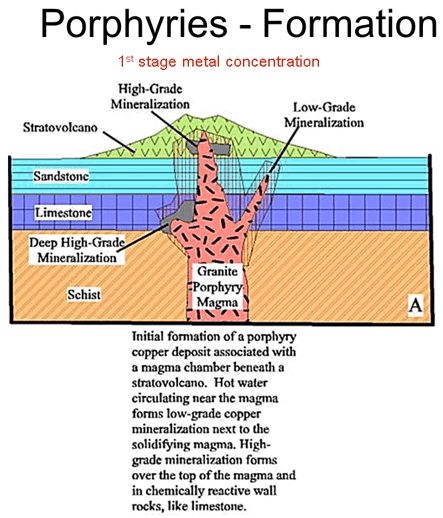
Now although primary porphyry mineralization generally has pretty modest grades subsequent weathering and erosion of the porphyry may pretty high grade secondary deposits of copper just below the water table. 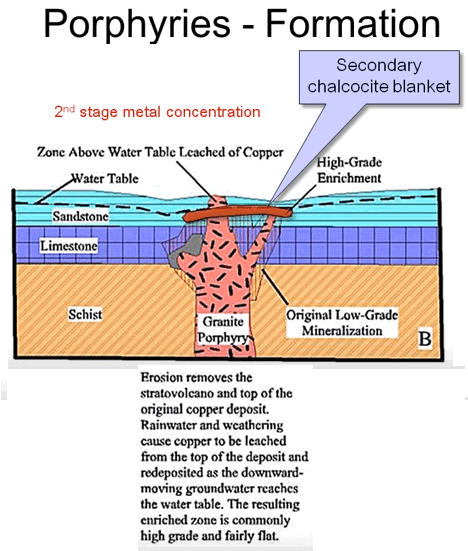 The oxygen above the water table allows primary copper sulfide such as chalcopyrite to break down to soluble copper salts. These percolate down to the water table with the rainwater. Once they reach the water table oxygen is cut off and the water becomes reduced causing copper sulfide in the form of chalcocite to be deposited. Chalcocite has a higher copper content than chalcopyrite and grades of 5 to 10% copper in a laterally continuous horizontal beds are not uncommon. This secondary enrichment may kick start the production of an otherwise mediocre porphyry deposit.
The oxygen above the water table allows primary copper sulfide such as chalcopyrite to break down to soluble copper salts. These percolate down to the water table with the rainwater. Once they reach the water table oxygen is cut off and the water becomes reduced causing copper sulfide in the form of chalcocite to be deposited. Chalcocite has a higher copper content than chalcopyrite and grades of 5 to 10% copper in a laterally continuous horizontal beds are not uncommon. This secondary enrichment may kick start the production of an otherwise mediocre porphyry deposit.
Following erosion many porphyries are covered by sediments are younger volcanics.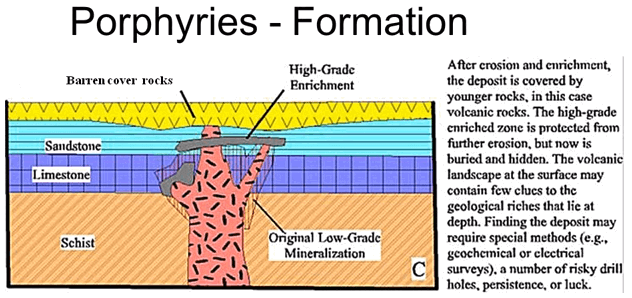
As I mentioned at the start of the Exploration Geology Courses, porphyry deposits are low grade but generally very large, as a result of the low grade and size few porphyries support expensive underground mining techniques and most are mined by open pit methods. This picture is of Bingham Canyon in Utah an aerial shot like this doesn’t give a true idea of just how big the pit is and you need to get on the ground to appreciate that. This is a photo from the edge of the pit and you can start to get an idea of the scale for the trucks climbing up the whole roads within the pit but you only really get a full understanding of the scale when you see one of those trucks standing next to a normal SUV. A CAT 797 has wheels 12 feet high and carries a payload of almost 400 tons. The driver probably barely noticed when he drove over this SUV everything about porphyry deposits is big.
Here are some of the biggest porphyries in the world you can see that these range in size from 2,000,000,000 tons up to Chuquicamata at a whopping 16,000,000,000 tons with a pit that is over 800 m deep or 2600 feet. Bingham which I showed a couple of slides back is a relative baby in this family a few economic porphyries are smaller than 100,000,000 tons but although they are big they are very low grade. Here are some of those same deposits arranged in order according to copper grade. They range from 0.5% copper up to just under 1% copper.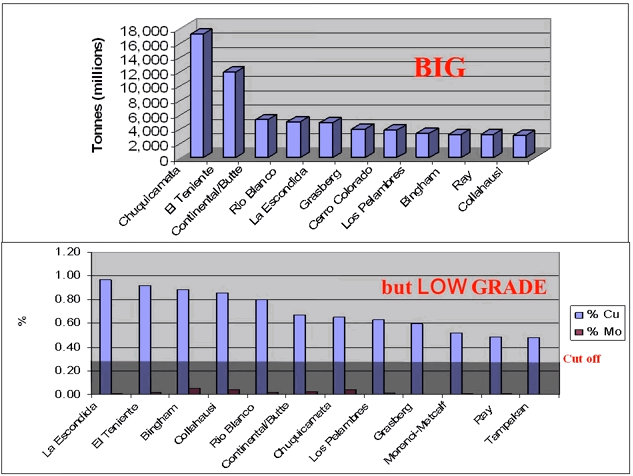
Compare those grades to those in Congo from with an average copper equivalent of 5% copper and you can see why they have to be big to make a profit and compete. This is not a porphyry deposit it’s one of the Central African copper belt style of deposit. If you take into account the probable cut off you can see how small the margins are porphyry deposits are very sensitive to metal prices. These examples are some of the cadillacs of the ore deposit worlds but other lower grade porphyry deposits can become uneconomic with just a 20% drop in copper price.
Here are some random drill results from Serengeti’s property in British Columbia which is more typical of the recent porphyry discoveries. Intercepts were checked against them are potentially economic the others are probably not and as you can see that maybe only 50% of those intercepts might possibly make any money.
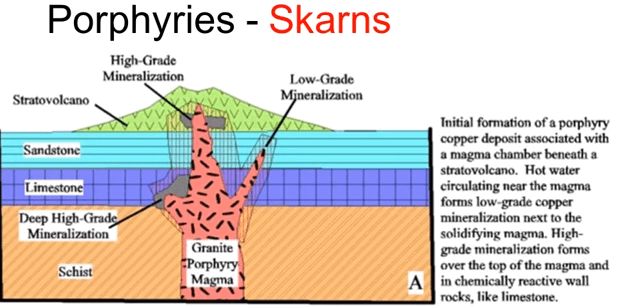
A different but closely related group of deposits to Porphyry Copper Deposits are the skarn deposits. Skarns are formed when hot magma intrudes the limestone the fluids from the intrusive alter the limestone to form an exoskarn. The intrusives also simulates the limestone altering its composition and forming and endo skarns. Either exo or endo skarns may host mineralization. 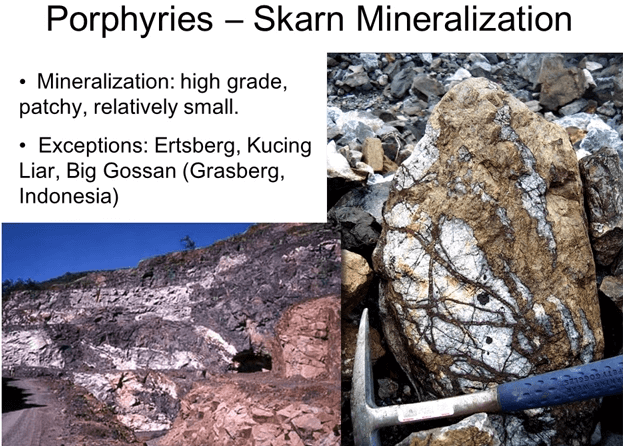 Skarns are often striking looking rocks containing red garnets and green pyroxenes. Grades may be high with splashy looking assays but they’re usually relatively small and irregular in shape and patchy as a result they are tricky to evaluate by drilling. In addition the ore tends to be very hard and it has a high work index so milling costs are high. There is some notable exceptions to the tendencies to produce relatively small deposits these are the Ertsberg, Kucin Liar and Big Gossans skarns developed around free ports Grasberg porphyry in Indonesia. These skarn deposits are truly world class but they are very atypical. These skarns are truly amazing deposits the picture on the left of the slide is the Grasberg pit developed on the Grasberg porphyry.
Skarns are often striking looking rocks containing red garnets and green pyroxenes. Grades may be high with splashy looking assays but they’re usually relatively small and irregular in shape and patchy as a result they are tricky to evaluate by drilling. In addition the ore tends to be very hard and it has a high work index so milling costs are high. There is some notable exceptions to the tendencies to produce relatively small deposits these are the Ertsberg, Kucin Liar and Big Gossans skarns developed around free ports Grasberg porphyry in Indonesia. These skarn deposits are truly world class but they are very atypical. These skarns are truly amazing deposits the picture on the left of the slide is the Grasberg pit developed on the Grasberg porphyry. 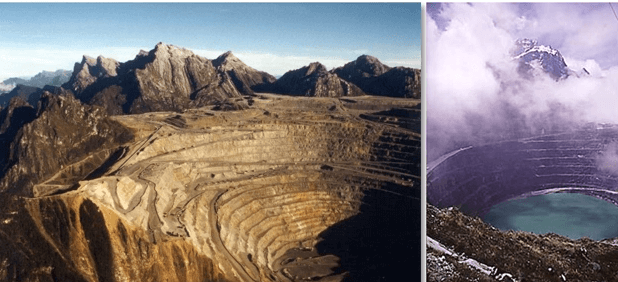 There are a number of other small intrusions in the area and several of these have developed the skarns. The picture on the right is of the old abandoned Ertsberg pit the very first one that led to the discovery of the Grasberg complex. That skarn had a high enough grade to allow it to continue to be mined from underground. The Big Gossans copper gold skarn deposit is the highest grade deposit in the Grasberg area. Reserves of 37,000,000 tons at 2.7% copper, 1 g per ton gold and 16 g of per ton silver that’s about $240 to $250 a ton rock. Grasberg and Ertsberg are almost in equator but because there are over 12,000 feet in elevation they receive snow from time to time as even nearby permanent glacier.
There are a number of other small intrusions in the area and several of these have developed the skarns. The picture on the right is of the old abandoned Ertsberg pit the very first one that led to the discovery of the Grasberg complex. That skarn had a high enough grade to allow it to continue to be mined from underground. The Big Gossans copper gold skarn deposit is the highest grade deposit in the Grasberg area. Reserves of 37,000,000 tons at 2.7% copper, 1 g per ton gold and 16 g of per ton silver that’s about $240 to $250 a ton rock. Grasberg and Ertsberg are almost in equator but because there are over 12,000 feet in elevation they receive snow from time to time as even nearby permanent glacier.
How to explore for large copper deposits?


